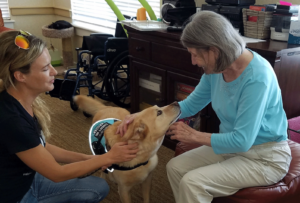How Animal Therapy Can Support Memory Care Residents
For many people, animals evoke fond memories of beloved pets. Bringing a dog into a room, for example, can prompt conversation, engagement, and emotional connections. Memory care residents may have similar responses. As we learn more about the many benefits of simply spending time with animals, memory care programs have started to incorporate animals into their programming with positive results.
Understanding Different Types of Animal Therapies and Activities

Michelle Djonova (far left), founder and executive director of the 1fur1 Foundation
Michelle Djonova, founder and executive director of the 1fur1 Foundation, explains that animal visits are often mislabeled. Animal-assisted interventions are on a macro group level, and that category includes all engagements that occur between a resident or client and an animal. “Under that umbrella, we break up the type of visits that are conducted with the assistance of a certified therapy animal,” she explains. Animal-assisted activities are more free-form, group-based activities. They might take place in a long-term living facility or hospice, and the whole facility would experience the interaction. Groups of participants can range from five to 100 residents.
“Animal-assisted therapy is a more structured, goal-oriented visit,” says Djonova. “It involves the coordination between a healthcare representative and handler that has happened before the visit. There’s a clear establishment of the goals for a patient or a smaller group.” Group sizes are usually five people or less.
“There’s also a new category of animal-related engagements,” Djonova explains. These engagements consist of virtual visits held over Zoom. The category developed within the animal-assisted intervention industry in March 2020, resulting from COVID-19 social distancing requirements. The sessions are usually activity-based and help address participants’ feelings of loneliness.
The Benefits of Animal Therapies for Memory Care Residents
Seeing how animal therapy benefitted memory care residents prompted Djonova to found the 1fur1 Foundation. In 2014, Djonova and her personal dog, Ripley, visited a woman in a memory care facility, starting with monthly 60-minute visits. “Her memory would reset pretty frequently,” explains Djonova. “We continued to visit her and increased the frequency to weekly visits, and that’s when we really saw the transformation happen right in front of our eyes. She was able to hold onto not only long-term memories and wasn’t resetting so quickly, but was also able to dig deep and find these long-term memories of when she had an animal.” Djonova notes that the resident’s verbal skills and engagement also improved.
“It was amazing to see how an animal can deliver the same benefit as a pill. We were able to offset some of her medication intake at that time,” says Djonova. “For the six months we visited, we saw that improvement.”
Djonova has seen similar benefits for other residents. “Residents in care settings get isolated, especially during the post-COVID wave we’re experiencing. You would be surprised how the animal can be a topic of conversation, and how it can spark conversation among residents and the handler.” She notes that just by visualizing and feeling the presence of an animal near them, residents can start to experience long-term memories.
She says it’s also common to see reduced stress, particularly with new residents who have recently joined the facility. “We’ve had a lot of folks open up to us about their life and that transition into the facility, so we feel that reducing that stress is a big benefit to animal-assisted activities and therapies,” says Djonova.
Additionally, she reveals that animal therapies may assist in a resident’s recovery from surgery or other medical issues. “We have also seen an increase in the speed of recovery time,” she notes.
What to Expect From Animal Therapy
According to Djonova, an animal and its handler will have done lots of preparation work before they even step foot into a memory care facility. The process starts with cleaning the animal to prevent the transmission of bacteria during the visit. Handlers have supplies like sanitizer, a towel, and sanitizing wipes, and they avoid putting the animal in any sort of costume. Not only could costumes potentially become stuck in equipment like wheelchairs, but if elements of the costume are sharp or detachable, they could pose a hazard for residents.
When animals and handlers visit senior care settings, they usually provide animal-assisted activities in a group setting. “Eighty-five percent of the time, visits take place in one or two locations,” says Djonova. “Usually, there’s a gathering room where all of the residents can come at their leisure. The residents have been informed of the activity and sit in a circle. We also go and visit the memory care section. We either go into the main room of that section of the facility, or we go room to room, depending on the setup.”
During the session, the handler and dog are always together. The handler engages with the residents, giving them a brief background about the dog, and the handler also learns who the residents are. The handler works to understand each resident’s limitations and desires, since some residents want to touch the dog, and others don’t. “If a resident is immobile, we need to account for that,” Djonova explains. “If they desire to physically touch the dog, we’ll bring the dog around to their wheelchair or to where they’re seated.” As the visit progresses, conversation naturally occurs, and some residents will share more than others.
How to Introduce Animal Therapy to a Memory Care Program
The 1fur1 Foundation provides free animal-assisted interventions to children and seniors with disabilities, including dementia and Alzheimer patients. The foundation accomplishes its work with the help of trained and certified therapy animals including dogs, horses, mini donkeys, mini horses, and a pig.
“All of our services are free of charge,” says Djonova. “As a 100% volunteer-driven charity, we rely on public donations, and we encourage educational partnerships, in which the facility informs the residents’ friend and family bases about what we’ve provided to them. Sometimes the family needs just as much education about what’s going on as the residents.”
Djonova encourages facilities interested in offering animal therapy to find a nonprofit in their area offering animal-assisted therapy or animal-assisted activities. “They can also reach out to us directly with their location and desired visit frequency, such as weekly, biweekly, or monthly. We can look for an active partner in their area that provides that service, and can connect them to that partner.”
She also notes that the 1fur1 Foundation often receives requests from facilities that want to get a facility dog. The Foundation has created a free factsheet that goes over the steps of getting a facility dog. “Facilities often think they can buy the dog,” she explains. “It’s a living being, so someone needs to adopt it and train it. It takes time and effort.”
Djonova explains that animal therapy is still a fairly new type of therapy. “People are starting to gravitate toward animal therapy, but more education is needed,” she says. “Animals can do so much for us cognitively, physically, and emotionally. Working with the elderly is a wonderful way to see those benefits in front of your eyes.”

Paige Cerulli is a contributing writer to i Advance Senior Care.
Related Articles
Topics: Activities , Facility management , Featured Articles , Resident Care











